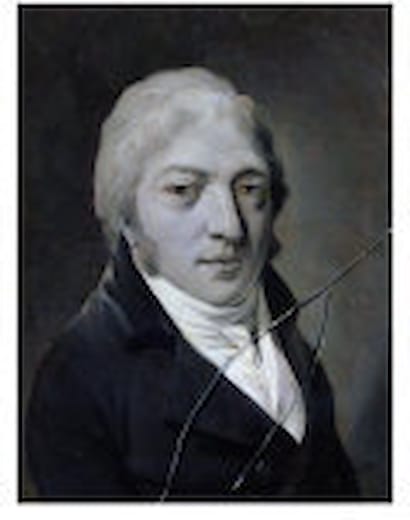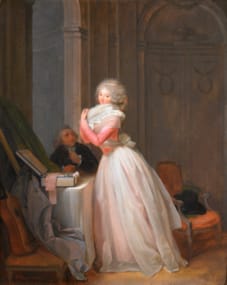
ouis Léopold Boilly
(Lille 1761 - Paris 1845)
 Biography
Biography The Suitor’s Gift
Biography
Boilly was born in Douai in northern France but moved to Arras at the age of seventeen to receive instruction in trompe l’oeil painting from Dominique Doncre (1743-1820). Seven years later Boilly moved to Paris where he exhibited in the Salon between 1791 and 1824 - receiving a gold medal in 1804. As discussed above, his early works tended towards a preference for amorous and moralising subjects. The Suitor’s Gift is comparable to much of his work in the 1790s, which ‘dealt with the love and family life of the urban middle and upper classes’.² His small-scale paintings with carefully mannered colouring and precise detailing - as demonstrated in his execution of the trinket box in the present painting - recalled the work of Dutch seventeenth-century genre painters such as Gabriel Metsu (1629-1667), Willem van Mieris and Gerard ter Borch (1617-1681), of whose work Boilly owned an important collection.
In 1794, Boilly was condemned by the Comité du Salut Public, at the height of the Terror, for the erotic undertones in his work Lovers and the Escaped Bird (The Louvre, Paris) and for painting subjects ‘d’une obscénité révoltante pour les moeurs républicaines’. This offence was remedied by an eleventh-hour discovery in his home of the more patriotic Triumph of Marat (Musée des Beaux Arts, Lille) which saved him from serious penalties. After the righteousness of the Terror, Boilly produced far less of these mildly erotic scenes and began to produce far more crowded compositions that which serve as social chronicals, an example being the Hermitage’s Game of Billiards (1807, The Hermitage, St. Petersburg; Yusupov Palace Museum, Leningrad. 1925). As Hallam notes ‘Boilly’s attitude toward genre painting has obviously changed, and the primacy of sensibilité has been conditioned, and at times replaced, by a journalistic desire to record and document everyday life’.³ As well as genre scenes, Boilly was well respected for his portraiture, producing many portraits of the middle classes and other famous contemporaries (for example, Robespierre now in the Musée des Beaux Arts, Lille) and recording fashionable Parisian life through the Revolution, the Directory, the Empire, and on into the Restoration period.










